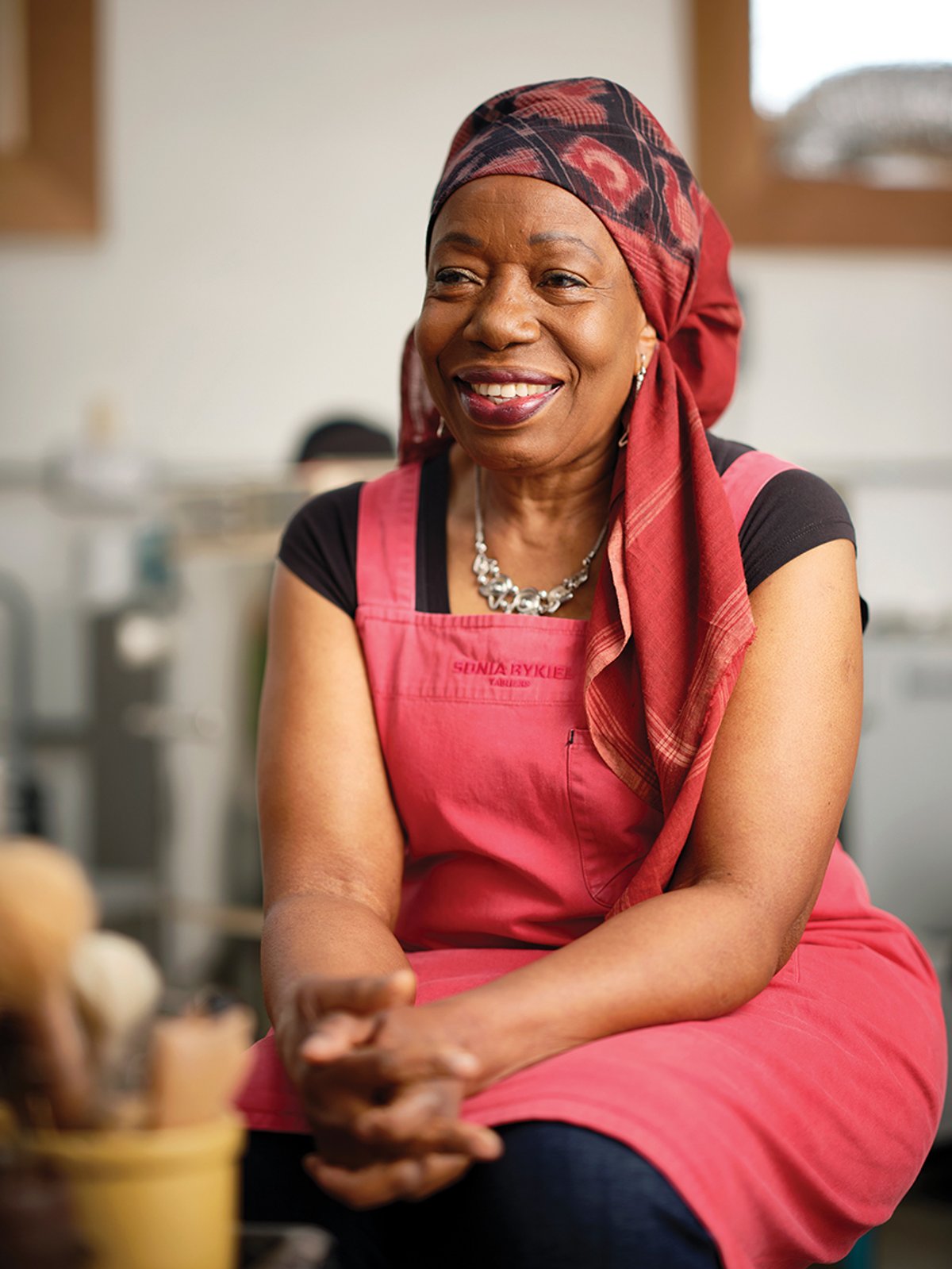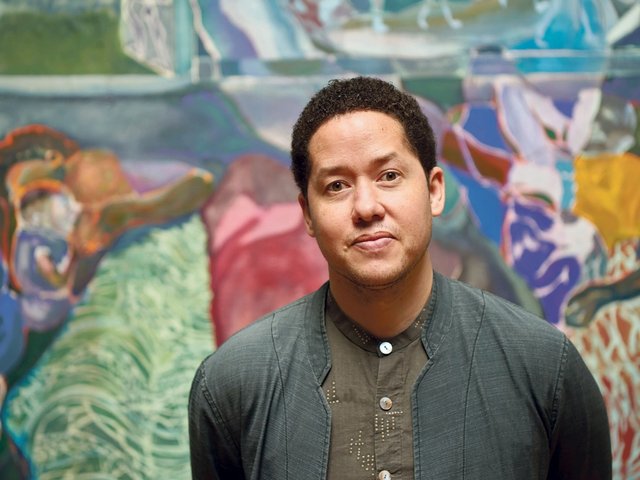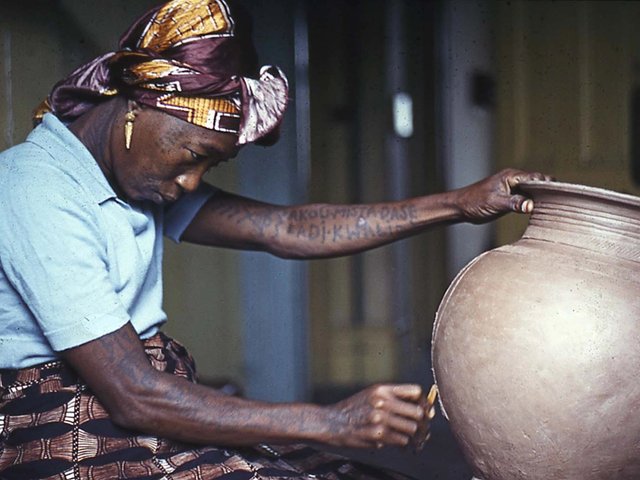Magdalene Odundo is internationally renowned for her distinctive burnished, hand-built vessels. These are repeatedly fired for richness of colour, and informed by art and craft traditions from around the world throughout history. These influences were especially evident in The Journey of Things, a landmark exhibition curated by Odundo in 2019 at the The Hepworth Wakefield and Sainsbury Centre, Norwich, which brought together more than 50 of her works alongside historic and contemporary objects.
Born and raised in Kenya, Odundo began her career at an advertising agency in Nairobi as a trainee layout artist before moving to the UK in 1971 to attend a foundation course in commercial art at Cambridge School of Art. Increasingly inspired to make work herself, she enrolled in a degree in ceramics, printmaking and photography at West Surrey College of Art and Design and then for an MA at the Royal College of Art. Odundo has spent more than 40 years in education as a maker, researcher, lecturer and examiner to various national and international universities and she is now the chancellor of the University for the Creative Arts. Her work is currently on show in Body Vessel Clay: Black Women, Ceramics and Contemporary Art at Two Temple Place in London and in a display at the Fitzwilliam Museum in Cambridge. From 29 March she is in a mixed exhibition, A Matter of Life and Death at Thomas Dane Gallery, Naples, and in April she is participating in The Milk of Dreams, the Venice Biennale exhibition curated by Cecilia Alemani.
The Art Newspaper: You are really covering all the art-world bases this year. How do you feel about your work being shown in so many different contexts?
Magdalene Odundo: I feel as if 40 years have paid off! I am absolutely delighted that through my work I’ve been able to bridge certain schisms within the cultural art tradition. And also being able to do what I always wanted to do, which was to reach a position or level where the art was being critically looked at in its own right, both within a particular moment, which is contemporary, but also with the recognition that the work is positioned within a historical perspective as well.
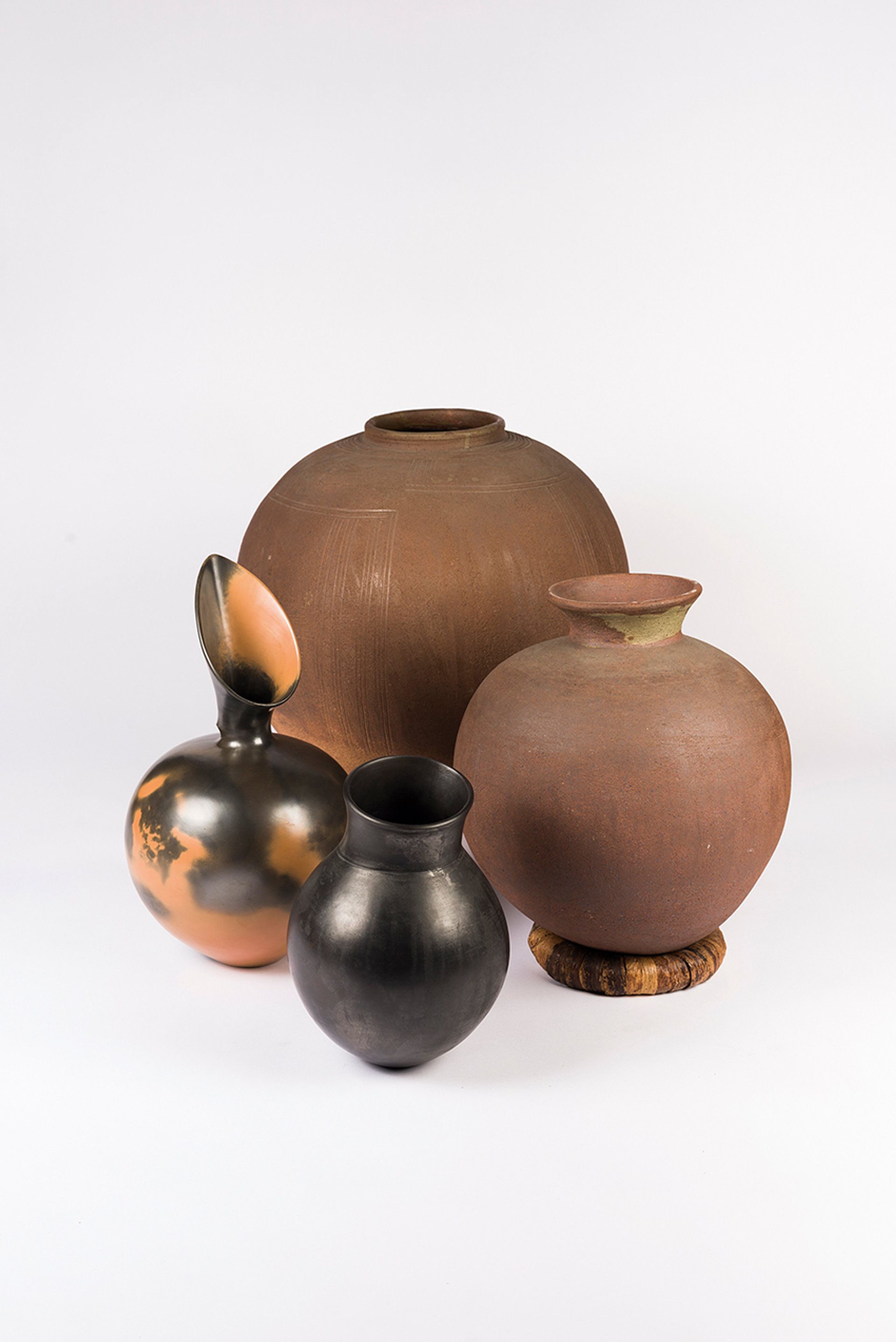
A group of Odundo’s characteristically burnished pots from the Body Vessel Clay show at Two Temple Place in London © Magdalene Odundo/York Museums Trust
You’ve said that you want your vessels “to be shaped by the global world we live in” and at the Fitzwilliam and in The Journey of Things you’ve shown your work alongside pieces spanning continents and centuries.
For me it’s just important that they shimmer and they dance and rub shoulders with all these others. Because the global world we live in is one world. The title for Venice [the Biennale], The Milk of Dreams, is just so apt, because years ago a piece that I found just so stunning was a milk pot from the Rift Valley of Kenya. Most of the time the Turkana and the Masai just keep their milk in gourds but this was a ceramic pot that was so sculptural and combined the notion of a gourd with a pitcher plant. So the idea of honey and milk being extracted were combined in a single piece, which I just remembered when Cecilia [Alemani, the curator] talked to me about the title.
It’s a telling story that when Eduardo Paolozzi, your tutor at the Royal College in the late 1970s, suggested that you went to the British Museum, he was surprised when you made a beeline not for the African pottery, but for the ceramics of the Victorian industrial designer Christopher Dresser.
It was very challenging for me, because he was being so complacent and had such assumptions of how I was thinking. Eduardo and his contemporaries had been looking at what was so-called primitive art and abstracting ideas from Africa, Oceania, the Pacific. I don’t think they had critically assessed the work to find out a little bit more about where it came from. Especially in Africa, the notion of extracting ideas from life is very important and that notion of the living and the afterlife is a very important aspect. It defines social structures within those communities. But I was always trying to have a wider and much more expansive reach in the way that I think about what and how I make. I wanted to have a historical perspective, but also to find a universal language in object-making and design as well as making individual work as a contemporary artist. A language couched in the critical analysis of the past uses outdated genres in which the work gets placed and where it can then get stuck.

Magdalene Odundo's Untitled Vessel: Symmetrical Series (2020). Courtesy of Thomas Dane Gallery
You grew up in Kenya and then came to the UK in 1971 to study graphic and commercial art—what inspired you to turn to ceramics?
We only had independence in Kenya in 1963 and we were still the children of freedom fighting. By the time I got to Cambridge the Black Power movement in the States was very alive and we gathered together, we looked at films, we studied books about the politics and started examining our status. And I began to think about advertising and how it was based on material possessions, and who in Africa could afford all these things? If advertising had been more educationally interesting and promoting betterment through healthcare and things like that, perhaps I might have felt more comfortable, philosophically and intellectually. But I wanted to find a way out of the commercial arts and on the advice of Zoë Ellison, who taught ceramics, I went to Farnham [West Surrey College of Art and Design], which offered applied art but which also had a very good complementary studies and history department. The printmaking department was very good—and I still like to make prints and photographs—but it was the ceramics that caught my eye because I suddenly realised that I really liked objects.
Why has clay remained your primary medium?
There’s much more humanity to clay than in other art forms, where you think first, and then you apply. Clay allows you to immerse yourself and to think with it—thinking and making are synchronised. You feel the clay through your body and your hands, particularly with hand building. It’s very different if you are just throwing clay about and making artistic statements and approaching it through thought, rather than the making. It’s the combination of having to make with clay and make it as perfect as you can, but also embedding yourself and losing yourself in this notion of a vessel, where you open up your soul, while opening up and then closing the clay as a bowl. Then you touch the neck and open the rim so that it becomes more human and animated. Once you’ve got that object there, it also allows you to embellish more by adding, subtracting or extracting. I like the fact that the material itself allows you to extemporise; you can play with it and, as you do, you’re attracting the characteristics of what it is to be human into that pot or vessel that you’ve made.
You’ve made the analogy of the vessel with the human body. Conceptually and formally, the human body seems to be your most enduring subject and inspiration.
Every day I go into the studio and when I start making a piece of work, I recall the movement of the people that I’ve been looking at when I’ve gone to a supermarket or to an exhibition. I tend to look at how people are interacting with whatever they are doing, even if they are just sitting and looking into space. I love thinking of that relaxation and the breathing that this person is emitting: breathing in and out, creating that vessel in the body, and then exhaling so the body moves back. When you make vessels like I do, they are still very porous because I fire the clay at a very low temperature.
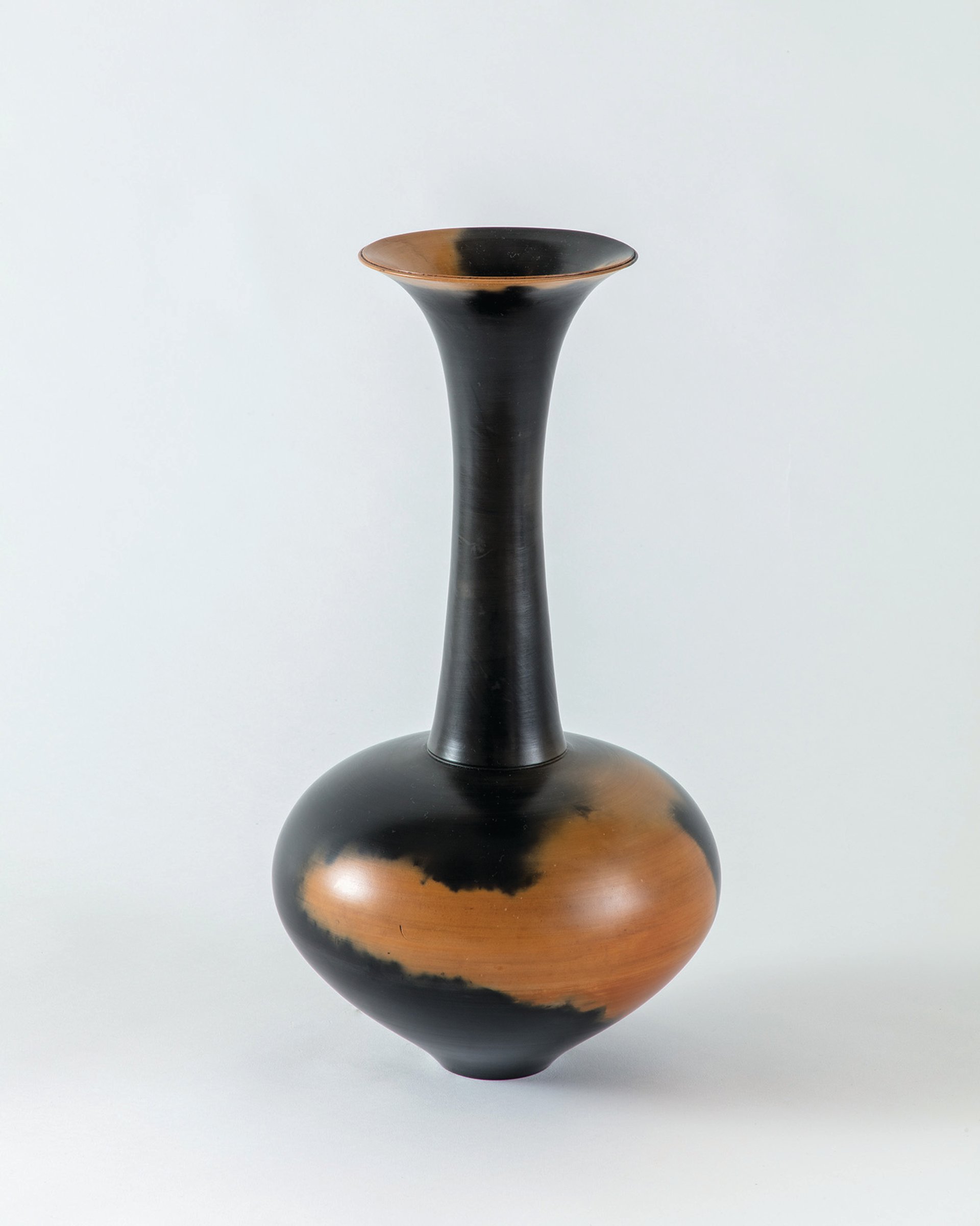
Magdalene Odundo's Untitled Vessel: Symmetrical Series (2021). Courtesy of Thomas Dane Gallery
Although your vessels aren’t functional, they tap into all those associations too.
Pots and vessels have always been these mediators of who we are as people: what we eat, what we cook, and how we use those vessels to enhance who we are, because they feed us and they enhance our being. Spiritually as well, throughout history people have used the vessel as a conduit, a piece that allows communities to get together and to serve as well as to be served from it. And I love the idea of burial ceramics. In East Africa where I come from, a person, especially a very prominent person, was buried sitting in a chamber surrounded by a whole lot of different vessels made out of clay for him to be able to feed himself. Then there are also the classical Greco-Roman pieces that allow depiction, you can draw on them and tell a story. Ceramics are a canvas that can allow you to depict and make graphical representations of whatever you are narrating, without having to write.
While you were still at the Royal College you spent two months at the Pottery Training Centre in Abuja, Nigeria, where you learned to hand build in the traditional Gwari method, a method which you still use. Why was this so important?
It’s hand building but it’s actually a very sculptural process. They are literally carving from the lump of clay and building up the wall. The Gwari don’t work with small rolls of sausage clay, they literally carve the clay out, make the vessel, and then later on when the piece is maybe a foot and a half tall, they just gouge a piece of clay and roll with a little bit in their hand. Like them, I wanted to be able to connect with the inside and outside of the walls of the clay that I was creating. I wanted to be thinking with the clay and it felt like a spiritual need to find that my soul, my eyes, my head were all working, trying to make form, trying to understand form, intellectually as well as physically. Then the way the Gwari people make the work is also very much like a dance, because the material, the clay, is static, it’s on a base and they walk around it. And it’s almost like they are dancing around this vessel that they’re carving. And then when they get to the rim, they really move fast, so fast that they’re spinning. So you imagine that they’re the wheels and they’re spinning. It’s very sculptural but it’s also that notion, that idea that you are the wheel.
You don’t use glazes but instead coat your vessels in slip, burnishing the surface and then firing in a gas kiln and controlling the amount of oxygen to determine whether they remain bright orange through oxidisation or turn iridescent black by reduction firing.
The firing is my least favourite form, I find it really torturous and I will prolong when I fire a work. But I think it's crucial, particularly for the oxidised, the terracotta red pieces. They have to be like the ballerina, they have to be perfect. And that's why there are fewer oranges because if they have any blemish on them, you can see it. The black carbonised pieces are just giving a flame the flame to finish them, it’s like the icing on a cake. Without that icing, the cake isn't perfect.
Times have radically changed from the 1980s when your vessels were regarded solely as craft or applied art. Now artists of all ages and inclinations are using clay for myriad purposes and hailing you as a major pioneer in the dissolving of these fine/applied art demarcations.
I feel so honoured to have young artists quote me—for me it’s like a job done. But there’s still always room for improvement and that’s why making art is such an important activity, because it’s always the next piece or the next work. You are always discovering something new to add to the work. But if I have been able to leave a trail, I hope it has been an honourable one.
• Magdalene Odundo is showing in Body Vessel Clay: Black Women, Ceramics and Contemporary Art, Two Temple Place, London, until 24 April; Magdalene Odundo in Cambridge, Fitzwilliam Museum, Cambridge, until 24 July; A Matter of Life and Death, Thomas Dane Gallery, Naples, 29 March-28 May; The Milk of Dreams, 59th Venice Biennale, 23 April-27 November


